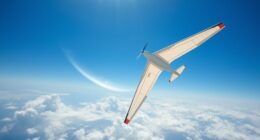I am thrilled to be your guide in this comprehensive tutorial on learning how to fly, as a passionate pilot.
Strap in and prepare for an exhilarating journey through the principles of flight, mastering navigation, and understanding aircraft controls.
We’ll dive into communication in the skies, emergency procedures, and the importance of aircraft maintenance and safety.
Along the way, you’ll gain the skills to fly solo and earn your pilot’s license, setting you on a successful course for a rewarding flying career.
So, let’s soar to new heights together!
Key Takeaways
- Lift is generated by the wings, aided by the airfoil shape.
- Understanding navigation and aviation charts is crucial for flight planning and navigation.
- Regular inspections and following safety procedures are necessary for aircraft maintenance and safety.
- Gaining the skills to fly solo is a significant milestone in a pilot’s journey and requires meeting specific requirements.
The Principles of Flight
Now that you’ve mastered the basics of flying, let’s dive into the principles that make it all possible.
Understanding the principles of lift and aircraft performance is crucial for any pilot. Lift is the force that allows an aircraft to overcome gravity and stay airborne. It is generated by the wings as they move through the air, creating a pressure difference between the upper and lower surfaces. The shape of the wing, known as the airfoil, plays a significant role in generating lift.
Additionally, aircraft performance refers to the capabilities and characteristics of an aircraft, such as speed, range, and maneuverability. By understanding these principles, pilots can make informed decisions and ensure safe and efficient flights.
Now, let’s move on to understanding aircraft controls and how they affect our flight.
Understanding Aircraft Controls
As a pilot, it is crucial to have a thorough understanding of the control surfaces that manipulate the aircraft’s movements. The ailerons, elevators, and rudders play key roles in controlling different aspects of the aircraft’s flight.
The ailerons, located on the wings, control the roll of the aircraft. They allow the aircraft to bank left or right, which is essential for turning.
The elevators, situated on the horizontal stabilizer, control the pitch of the aircraft. They enable the aircraft to climb or descend, helping to control the altitude.
Lastly, the rudder, positioned on the vertical stabilizer, controls the yaw of the aircraft. It allows the aircraft to turn left or right, helping to change the direction of flight.
Coordinating these controls effectively is essential for maintaining control and stability during flight. Understanding how each control surface works and how they interact with each other is crucial for a pilot to safely maneuver the aircraft.
The Control Surfaces: Ailerons, Elevators, and Rudders
The ailerons, elevators, and rudders are crucial control surfaces in flying. These control surfaces are meticulously designed to ensure precise maneuverability and stability during flight. Flight dynamics analysis plays a vital role in optimizing their design and effectiveness.
Here are five emotions these control surfaces evoke in the audience:
- Excitement: The ailerons allow for exhilarating rolls and loops, adding a thrilling element to flying.
- Confidence: The elevators provide pitch control, giving pilots the assurance to maintain altitude and adjust climb or descent rates.
- Control: The rudders enable precise yaw control, ensuring stable turns and coordinated flight.
- Safety: These control surfaces contribute to the overall stability and control of the aircraft, enhancing safety during flight.
- Freedom: The ailerons, elevators, and rudders empower pilots to explore the skies, giving them a sense of freedom and adventure.
Understanding the importance of these control surfaces sets the foundation for learning how to coordinate your controls seamlessly, without sacrificing precision or control.
How to Coordinate Your Controls
Coordinating your controls is key to maintaining stability and precision during flight. It allows you to seamlessly maneuver the aircraft and make adjustments as necessary.
When it comes to maintaining proper altitude, coordinating the elevator and throttle controls is crucial. By adjusting the elevator, you can control the pitch of the aircraft and ensure a steady climb or descent. Simultaneously, managing the throttle will help you maintain the desired airspeed.
In emergency situations, coordinating controls becomes even more vital. For instance, if you encounter an engine failure, you need to immediately decrease the throttle, while simultaneously applying opposite rudder to counteract the yaw. This will help you maintain control and prevent a spin.
By understanding and practicing the art of coordinating controls, you will be better equipped to handle any situation that comes your way, ensuring a safe and precise flight.
Moving on to mastering navigation…
Mastering Navigation
Understanding VFR and IFR, reading aviation charts and maps, and using navigation instruments are crucial skills for any pilot.
VFR, or Visual Flight Rules, refer to flying by visual reference to the ground, while IFR, or Instrument Flight Rules, involve relying on instruments for navigation.
Aviation charts and maps provide essential information about airspace, navigation aids, and obstacles, helping pilots plan and navigate their flights.
Navigation instruments, such as GPS, VOR, and ADF, aid in determining position, tracking course, and measuring distance during flight.
Understanding VFR and IFR
VFR and IFR are two different types of flight rules pilots must be familiar with. Visual Flight Rules (VFR) are used when the weather conditions are clear and pilots can navigate by visually referencing the ground and landmarks. On the other hand, Instrument Flight Rules (IFR) are used when the weather conditions are poor and pilots rely on instruments to navigate.
Understanding the differences between VFR and IFR is crucial for pilots to operate safely and efficiently. Here are four key points to remember:
- VFR allows for more flexibility and freedom in choosing flight paths.
- IFR requires strict adherence to air traffic control instructions.
- VFR pilots must have good visibility and clear weather conditions.
- IFR pilots rely on instruments to navigate and communicate with air traffic control.
Now, let’s transition into the next section, where we will explore the importance of reading aviation charts and maps in order to navigate effectively during flights.
Reading Aviation Charts and Maps
As a pilot, you’ll find that reading aviation charts and maps is essential for effectively navigating during your flights. Aviation charts provide crucial information about airspace, navigation aids, and communication frequencies. They help us plan our flight routes and make informed decisions while in the air. Maps, on the other hand, provide a visual representation of the terrain and landmarks, enabling us to identify key features and plan our flight accordingly. Let’s take a look at a sample table that showcases the different types of aviation charts and their purposes:
| Chart Type | Purpose |
|---|---|
| Sectional Chart | Provides detailed information about VFR navigation, including topographic features, airports, and airspace boundaries. |
| IFR Enroute Chart | Designed for IFR flights, it displays high altitude jet routes, airways, and navigation aids. |
| Terminal Area Chart | Focuses on specific airports and provides details on communication frequencies, instrument approach procedures, and airspace restrictions. |
| VFR Navigation Chart | Offers a broader overview of a region and includes topographic information, airspaces, and navigation aids. |
| Helicopter Route Chart | Specifically designed for helicopter pilots, it displays low altitude routes and heliports. |
Using Navigation Instruments
Now let’s take a look at how you can use navigation instruments to enhance your flying skills.
Navigation instruments play a crucial role in ensuring accurate and safe navigation during a flight. One important aspect is instrument calibration, which ensures that the readings provided by these instruments are accurate and reliable.
Calibrating instruments, such as the altimeter, airspeed indicator, and heading indicator, is essential before each flight to ensure precise measurements.
Additionally, using GPS navigation has become increasingly popular in modern aviation. GPS provides real-time position information, allowing pilots to accurately track their flight path and navigate to their desired destinations.
By utilizing these navigation instruments and incorporating GPS technology, pilots can enhance their flying skills and navigate with confidence.
As we delve into communication in the skies, it is important to maintain effective communication with air traffic control and fellow pilots to ensure a safe and efficient flight.
Communication in the Skies
Pilots can use radio communication to stay in contact with air traffic control. This is an essential aspect of cockpit communication, ensuring safe navigation and efficient coordination in the skies. With the help of advanced technology and precise procedures, pilots can effectively transmit and receive vital information during their flight.
To evoke a sense of responsibility and professionalism in pilots, it is crucial to emphasize the importance of clear and concise communication.
One incorrect transmission can lead to catastrophic consequences, emphasizing the need for accuracy and attentiveness.
Effective communication with air traffic control helps pilots stay informed about weather conditions, air traffic congestion, and any potential hazards, allowing for timely adjustments to the flight plan.
Preparing for Takeoff and Landing
To ensure a safe and smooth takeoff and landing, you’ll need to carefully follow the guidelines provided by air traffic control. One essential tool for pilots is the takeoff checklist, which ensures that all necessary steps are completed before leaving the ground.
This checklist includes items such as checking the aircraft’s fuel quantity, ensuring the engines are running smoothly, and verifying that all control surfaces are functioning properly.
Additionally, regular maintenance of the landing gear is crucial to ensure its reliability during landing. This includes inspecting the tires for proper inflation and wear, checking the brakes for any abnormalities, and confirming that the landing gear doors are operating correctly.
By following these procedures, pilots can minimize the risk of mechanical failures and ensure a safe flight.
Now, let’s move on to the next important aspect of flying: weather and flight planning.
Weather and Flight Planning
When it comes to weather and flight planning, it is crucial to have a solid understanding of reading weather reports and forecasts. By analyzing this information, pilots can make informed decisions about their flight path and anticipate any potential challenges.
Planning for crosswind and bad weather conditions is another important aspect, as it allows pilots to prepare for the impact these conditions may have on their aircraft and adjust their flight plan accordingly.
Additionally, understanding weather hazards is vital for ensuring the safety of the flight and the passengers on board, as it enables pilots to navigate around or through hazardous weather conditions.
Reading Weather Reports and Forecasts
Understanding weather reports and forecasts is crucial for pilots to make informed decisions during their flights. As a pilot, I rely on accurate weather information to ensure the safety and efficiency of my journey. Here are some key points to consider when reading weather reports and forecasts:
-
Meteorological Symbols: Familiarize yourself with the symbols used to represent different weather conditions, such as clouds, precipitation, and visibility.
-
Interpretation: Learn how to interpret the information provided in weather reports, including temperature, wind direction and speed, and atmospheric pressure.
-
Forecasting Accuracy: Understand the limitations and uncertainties associated with weather forecasts. Keep in mind that forecasts are based on models and can change rapidly.
-
Cross-referencing: Verify the accuracy of weather reports by cross-referencing information from multiple sources, such as local weather stations and aviation-specific meteorological services.
How to Plan for Crosswind and Bad Weather Conditions
After gaining a thorough understanding of weather reports and forecasts, it is crucial for any pilot to plan for emergencies and be prepared to cope with turbulence caused by crosswind and bad weather conditions.
As a pilot, I must consider various factors when planning my flight path, such as wind speed and direction, cloud cover, and precipitation. By utilizing resources like weather radar and satellite imagery, I can anticipate potential hazards and adjust my route accordingly.
Additionally, I must ensure that my aircraft is equipped with the necessary instruments and systems to handle turbulent conditions, such as strong gusts or thunderstorms. By proactively planning for emergencies and being prepared for turbulence, I can navigate safely through challenging weather conditions and maintain the utmost safety for myself and my passengers.
Understanding weather hazards is a crucial aspect of flight navigation, allowing pilots to make informed decisions and ensure a smooth and secure journey.
Understanding Weather Hazards
To stay safe during your flight, it’s important for you, as a pilot, to be aware of the potential hazards associated with different weather conditions. Weather forecasting and aviation meteorology play a crucial role in providing pilots with the necessary information to make informed decisions regarding their flight path.
By understanding weather hazards, such as thunderstorms, icing conditions, or low visibility, pilots can anticipate and plan accordingly. These hazards can affect aircraft performance, navigation systems, and overall safety.
It is essential to continuously monitor weather updates and consult with meteorologists for accurate and up-to-date information. Being knowledgeable about weather patterns and their potential impact on your flight allows you to adapt your plan, make necessary adjustments, and ensure a safe journey.
Understanding these hazards sets the foundation for effective emergency procedures, which we will explore in the next section.
Emergency Procedures
In case of an emergency, it’s crucial to remember the proper procedures. When it comes to emergency landing procedures, pilots are trained to prioritize the safety of the passengers and crew. The first step is to assess the situation and communicate with air traffic control to request immediate assistance.
In-flight medical emergencies require quick thinking and action. Pilots are equipped with medical kits and have access to medical professionals on the ground who can provide guidance. They may also divert the flight to the nearest suitable airport for medical assistance. Ensuring the safety of everyone onboard is of utmost importance.
Transitioning into the next section about aircraft maintenance and safety, it is essential to have a well-maintained aircraft to prevent emergencies from occurring in the first place.
Aircraft Maintenance and Safety
During flight training, it is crucial to understand the significance of aircraft maintenance and safety. As a pilot, I am responsible for ensuring the aircraft is in optimal condition before every flight. This involves adhering to strict maintenance procedures, which include regular inspections, routine maintenance, and component replacements as necessary. To help visualize the importance of aircraft maintenance, I have prepared a table below:
| Maintenance Procedure | Frequency | Importance |
|---|---|---|
| Pre-flight inspection | Before every flight | Ensures aircraft is airworthy and safe |
| Routine maintenance | As per manufacturer guidelines | Prevents potential issues and prolongs aircraft life |
| Component replacements | As per maintenance schedule | Ensures proper functionality and minimizes failures |
Apart from regular maintenance, it is equally vital to be well-versed in emergency procedures to handle in-flight emergencies effectively. This includes understanding emergency checklists, practicing emergency maneuvers, and communicating with air traffic control. By prioritizing aircraft maintenance and safety procedures, pilots can mitigate risks and ensure a safe flying experience for themselves and their passengers.
Transitioning into the subsequent section about ‘flying solo and earning your pilot’s license,’ one of the most significant milestones in a pilot’s journey is gaining the confidence and competence to fly solo.
Flying Solo and Earning Your Pilot’s License
Gaining the confidence and competence to fly solo is a significant milestone in a pilot’s journey. It marks the culmination of hours of training and preparation, as well as the attainment of a private license. Here are three key factors to consider when embarking on this exciting phase of becoming a pilot:
-
Mastery of flight maneuvers: To fly solo, one must demonstrate proficiency in a range of maneuvers, including takeoffs, landings, and emergency procedures. This requires practice, precision, and a deep understanding of aerodynamics.
-
Knowledge of regulations: Earning a private license entails studying and understanding the rules and regulations that govern aviation. This includes airspace restrictions, weather minimums, and navigation procedures. Compliance with these guidelines is crucial for a safe and successful solo flight.
-
Decision-making skills: Flying solo requires making split-second decisions in critical situations. Pilots must develop the ability to assess risks, evaluate alternatives, and choose the best course of action. This requires a combination of knowledge, experience, and sound judgment.
Transitioning from flying solo to building a successful flying career involves more than just technical skills. It requires continuous learning, adaptability, and a passion for aviation.
Tips for a Successful Flying Career
Transitioning from flying solo to building a successful flying career involves continuous learning, adaptability, and a passion for aviation.
As a pilot, I understand the importance of constantly honing my skills and staying up-to-date with the latest industry advancements.
To achieve career advancement, it is crucial to seize networking opportunities within the aviation community. Attending industry events, joining professional organizations, and connecting with fellow aviators can open doors to new opportunities and valuable connections.
Building a successful flying career also requires a deep understanding of the technical aspects of aviation. Mastering navigation systems, aircraft operations, and safety protocols is essential.
Ultimately, a successful flying career is built on a foundation of knowledge, adaptability, and a genuine love for flying.
Through continuous learning and embracing networking opportunities, the sky truly is the limit.
Frequently Asked Questions
How much does flight training cost?
Flight training costs vary depending on factors such as location, type of aircraft, and individual needs. However, there are flight training scholarships and financing options available to help offset these expenses and make training more affordable.
What are the physical requirements to become a pilot?
To become a pilot, physical fitness is crucial. Pilots must meet certain medical requirements and pass regular exams to ensure they are in good health and able to handle the demands of flying.
Can I become a pilot if I wear glasses or contact lenses?
Yes, you can become a pilot even if you wear glasses or contact lenses. However, there are specific restrictions on glasses, such as limits on frame size and astigmatism correction, to ensure optimal vision during flight.
How long does it take to earn a pilot’s license?
It typically takes around 6-12 months to earn a pilot’s license, depending on the individual’s dedication and availability. While flight training expenses can be a concern, the investment is worth the rewarding career and lifelong passion for flying.
Are there any age restrictions for becoming a pilot?
There are age restrictions for pilot training and obtaining a pilot’s license. The specific age limits vary depending on the type of license, but generally range from 16 to 18 years old.
Conclusion
In conclusion, learning to fly is an exciting and fulfilling journey that requires dedication and a strong foundation in aviation knowledge.
While some may argue that the process can be overwhelming or too technical, this comprehensive guide breaks down the principles of flight, aircraft controls, navigation, communication, and emergency procedures in a precise and knowledgeable manner.
By following this guide and obtaining your pilot’s license, you can embark on a successful flying career. Don’t let any initial doubts hold you back – take the first step and let your flight path begin!
With a heart that soars as high as the skies, Aria, affectionately known as “Skylark,” is the driving force behind Soaring Skyways. Her journey into the gliding world began as a young dreamer gazing up at the soaring birds, yearning to experience the weightlessness and freedom they embodied. With years of experience both in the cockpit and behind the scenes, Aria’s commitment to the gliding community is unwavering.










